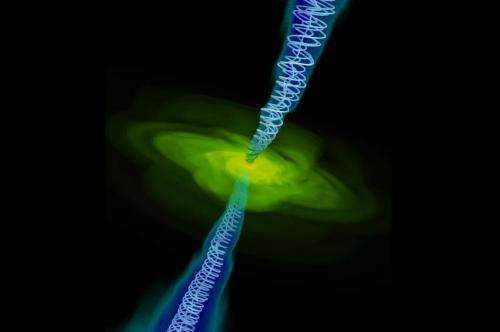Surprisingly strong magnetic fields challenge black holes' pull

A new study of supermassive black holes at the centers of galaxies has found magnetic fields play an impressive role in the systems' dynamics. In fact, in dozens of black holes surveyed, the magnetic field strength matched the force produced by the black holes' powerful gravitational pull, says a team of scientists from the U.S. Department of Energy's Lawrence Berkeley National Laboratory and Max Planck Institute for Radio Astronomy (MPIfR) in Bonn, Germany. The findings are published in this week's issue of Nature.
"This paper for the first time systematically measures the strength of magnetic fields near black holes," says Alexander Tchekhovskoy, the Berkeley Lab researcher who helped interpret the observational data within the context of existing computational models. "This is important because we had no idea, and now we have evidence from not just one, not just two, but from 76 black holes."
Previously, Tchekhovskoy, who is also a postdoctoral fellow at the University of California, Berkeley, had developed computational models of black holes that included magnetic fields. His models suggested a black hole could sustain a magnetic field that was as strong as its gravity, but there was not yet observational evidence to support this prediction. With the two forces balancing out, a cloud of gas caught on top of the magnetic field would be spared the pull of gravity and instead levitate in place.
The magnetic field strength was confirmed by evidence from jets of gas that shoot away from supermassive black holes. Formed by magnetic fields, these jets produce a radio emission. "We realized that the radio emission from black holes' jets can be used to measure the magnetic field strength near the black hold itself," says Mohammad Zamaninasab, the lead author of the study, who did the work while at MPIfR.
Other research teams had previously collected radio-emission data from "radio-loud" galaxies using the Very Long Baseline Array, a vast network of radio telescopes in the United States. The researchers analyzed this pre-existing data to create radio-emission maps at different wavelengths. Shifts in jet features between different maps let them calculate the field strength near the black hole.
Based on the results, the team found not only that the measured magnetic fields can be as strong as a black hole's gravity, but that they are also comparable in strength to those produced inside MRI machines found in hospitals—roughly 10,000 times greater than the field of the Earth itself.
Tchekhovskoy says the new results mean theorists must re-evaluate their understanding of black-hole behavior. "The magnetic fields are strong enough to dramatically alter how gas falls into black holes and how gas produces outflows that we do observe, much stronger than what has usually been assumed," he says. "We need to go back and look at our models once again."
More information: Paper: Dynamically important magnetic fields near accreting supermassive black holes, DOI: 10.1038/nature13399
Journal information: Nature
Provided by Lawrence Berkeley National Laboratory



















